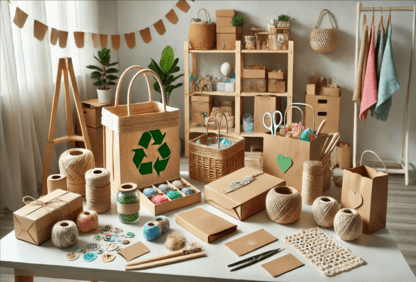In today’s world, sustainability is a priority for many consumers. Creating eco-friendly packaging for your crafts not only helps the environment but also adds value to your brand and attracts environmentally conscious customers. Here’s a practical guide to developing sustainable packaging that is both beautiful and functional.
1. Choose Eco-Friendly Materials
Selecting materials with minimal environmental impact is the first step toward sustainable packaging.
- Kraft Paper: A versatile, recyclable option for wrapping and box materials.
- Biodegradable Plastics: Use compostable bags for protecting delicate items.
- Recycled Cardboard: Ideal for boxes and inserts.
- Natural Fibers: Consider cotton twine or jute instead of synthetic ribbons.
Tip: Avoid excessive use of non-recyclable materials like plastic and instead opt for reusable or biodegradable options.
2. Design Minimalist Packaging
Less is often more when it comes to sustainability.
- Avoid Over-Packaging: Use only what’s necessary to protect the product.
- Simple Wrapping: A kraft paper wrap with a natural twine bow can look elegant and eco-friendly.
- Eliminate Plastic Fillers: Use shredded recycled paper or tissue paper instead of bubble wrap or foam.
Example: Wrap your crafts in tissue paper, seal it with a sticker, and place it in a snug cardboard box.
3. Incorporate Reusable Elements
Encourage customers to reuse parts of your packaging.
- Decorative Boxes: Use sturdy, well-designed boxes that can double as storage containers.
- Fabric Wrapping: Wrap products in reusable cloth bags or fabric squares.
- Multi-Functional Tags: Include tags that can be repurposed as bookmarks or decorations.
Tip: Add a small note encouraging customers to reuse or recycle the packaging.
4. Highlight Your Sustainability Efforts
Let your customers know that you prioritize the environment.
- Eco-Friendly Labels: Print “100% Recyclable” or “Made with Recycled Materials” on your packaging.
- Informative Inserts: Include a card explaining the sustainable materials used and how to recycle or repurpose the packaging.
- Share Your Story: Highlight your commitment to sustainability on your website and social media.
Example: “This box is made from 80% recycled cardboard and is fully recyclable. Please recycle or reuse it!”
5. Source Locally
Reducing the carbon footprint of your packaging starts with sourcing materials closer to home.
- Local Suppliers: Partner with local manufacturers for boxes, paper, and printing.
- Reduce Shipping Impact: Fewer transportation miles mean lower emissions.
Tip: Local sourcing can also reduce costs and strengthen community ties.
6. Customize Your Packaging
Make your eco-friendly packaging unique to your brand.
- Custom Stamps: Use stamps with your logo instead of printed designs to minimize ink use.
- Branded Stickers: Add your logo with biodegradable or compostable sticker materials.
- Personal Touches: Include a handwritten thank-you note or a simple drawing.
Example: “Handmade with care – Thank you for supporting small businesses!”
7. Offer Packaging-Free Options
For customers who are particularly eco-conscious, consider offering a packaging-free option.
- Digital Receipts: Avoid printing receipts and instead send them via email.
- Simple Wraps: For local deliveries, skip the outer packaging and use only the necessary protection.
- Customer Choice: Let customers opt out of packaging during checkout.
Tip: Clearly communicate the option for minimal or no packaging on your website or shop.
8. Encourage Recycling
Make it easy for your customers to dispose of packaging responsibly.
- Recycling Instructions: Provide clear guidance on how to recycle each part of the packaging.
- QR Codes: Include QR codes linking to a webpage with recycling tips.
- Take-Back Programs: Offer incentives for customers who return packaging to be reused.
Example: “Recycle this box with your curbside recycling or repurpose it for storage!”
9. Stay Creative
Sustainable packaging doesn’t mean sacrificing style.
- Nature-Inspired Designs: Use earthy tones, botanical patterns, or minimalist aesthetics.
- Eco-Friendly Printing: Use water-based inks or soy-based dyes for a sustainable touch.
- Add Greenery: Include small dried flowers or herbs for a charming, natural accent.
Tip: Balance simplicity with creativity to create memorable packaging that reflects your brand.
10. Monitor and Improve
Sustainability is an ongoing process. Regularly evaluate your packaging practices and look for areas to improve.
- Gather Feedback: Ask customers for input on your packaging and how it can be better.
- Stay Informed: Keep up with new sustainable materials and trends in eco-friendly packaging.
- Test New Ideas: Experiment with innovative solutions, such as compostable mailers or plant-based adhesives.
Conclusion: Packaging That Reflects Your Values
Sustainable packaging is an opportunity to showcase your commitment to the environment while enhancing your brand’s appeal. By using eco-friendly materials, embracing minimalism, and adding personal touches, you can create packaging that delights your customers and aligns with their values. Start implementing these tips today to elevate your craft business and contribute to a greener planet!

